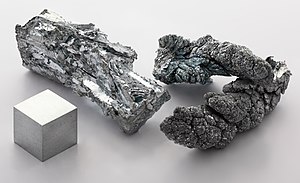 |
|
| Appearance | silver-gray |
|---|
| Standard atomic weight (Ar, standard) | 65.38(2) |
|---|
|
|
| Atomic number (Z) | 30 |
|---|
| Group | group 12 |
|---|
| Period | period 4 |
|---|
| Block | d-block |
|---|
| Element category | post-transition metal, alternatively considered a transition metal |
|---|
| Electron configuration | [Ar] 3d10 4s2 |
|---|
Electrons per shell | 2, 8, 18, 2 |
|---|
|
| Phase at STP | Zn: Solid |
|---|
| Melting point | 692.68 K (419.53 °C, 787.15 °F) |
|---|
| Boiling point | 1180 K (907 °C, 1665 °F) |
|---|
| Density (near r.t.) | 7.14 g/cm3 |
|---|
| when liquid (at m.p.) | 6.57 g/cm3 |
|---|
| Heat of fusion | 7.32 kJ/mol |
|---|
| Heat of vaporization | 115 kJ/mol |
|---|
| Molar heat capacity | 25.470 J/(mol·K) |
|---|
Vapor pressure| P (Pa) | 1 | 10 | 100 | 1 k | 10 k | 100 k |
|---|
| at T (K) | 610 | 670 | 750 | 852 | 990 | 1179 |
|---|
|
|
| Oxidation states | −2, 0, +1, +2 (an amphoteric oxide) |
|---|
| Electronegativity | Pauling scale: 1.65 |
|---|
| Ionization energies | - 1st: 906.4 kJ/mol
- 2nd: 1733.3 kJ/mol
- 3rd: 3833 kJ/mol
- (more)
|
|---|
| Atomic radius | empirical: 134 pm |
|---|
| Covalent radius | 122±4 pm |
|---|
| Van der Waals radius | 139 pm |
|---|
| Spectral lines of zinc |
|
| Natural occurrence | Zn: Primordial |
|---|
| Crystal structure | hexagonal close-packed (hcp) |
|---|
| Speed of sound thin rod | 3850 m/s (at r.t.) (rolled) |
|---|
| Thermal expansion | 30.2 µm/(m·K) (at 25 °C) |
|---|
| Thermal conductivity | 116 W/(m·K) |
|---|
| Electrical resistivity | 59.0 nΩ·m (at 20 °C) |
|---|
| Magnetic ordering | diamagnetic |
|---|
| Magnetic susceptibility | −11.4·10−6 cm3/mol (298 K) |
|---|
| Young's modulus | 108 GPa |
|---|
| Shear modulus | 43 GPa |
|---|
| Bulk modulus | 70 GPa |
|---|
| Poisson ratio | 0.25 |
|---|
| Mohs hardness | 2.5 |
|---|
| Brinell hardness | 327–412 MPa |
|---|
| CAS Number | 7440-66-6 |
|---|
|
| Discovery | Indian metallurgists (before 1000 BCE) |
|---|
| First isolation | Andreas Sigismund Marggraf (1746) |
|---|
| Recognized as a unique metal by | Rasaratna Samuccaya (800) |
|---|
|
|
| | references |




